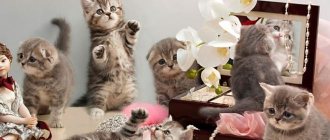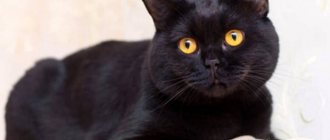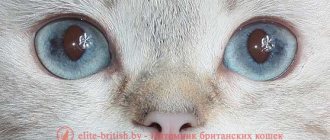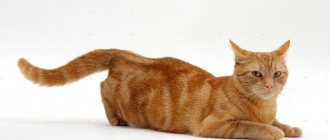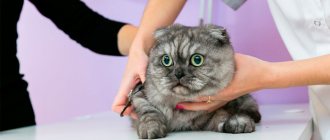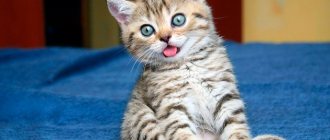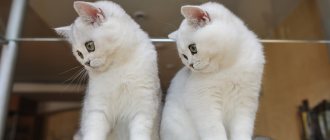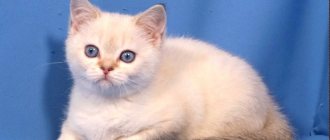Is it necessary and possible to have a haircut?
If we exclude the owner's pursuit of his aesthetic interests, then in some circumstances it is not only possible, but also necessary to trim the cat.
Grooming cats is advisable for long-haired breeds. They are characterized by such features as the formation of matted tangles and regular contamination in the tray when performing natural needs.
However, they are not the only ones who suffer from too rich fur coats. The reason for cutting any breed can be:
- summer heat. Even short-haired cats can hardly tolerate it;
- heavy shedding. A haircut has its own benefits for the owner: less hated hair in the house and no need for combing. For a cat, this is a guarantee that lumps will not form in the stomach and everything will be fine with digestion.
So, there are many reasons to get a haircut. Even if we do not take into account the aesthetic side of the problem. The only question that remains is: how to cut and how much hair to leave on the body?
Why cut a cat's hair?
The need for a haircut is determined by the owner. You can do without it, but you need to regularly take care of your body, comb it, preventing the formation of tangles. More often they affect Persian cats, whose hair structure is soft and its length reaches up to 10 cm.
Tangles that are close to the skin are very dangerous. This provokes inflammation of the integument, sometimes insects and parasites lay eggs under them. Therefore, long-haired cats need to be trimmed more often. Indications for hygienic trimming and shaving are:
- The neglected state of the cat's hair is matted, covered with tangles, and difficult to comb. This prevents the access of air, which provokes the development of inflammation and skin tightness. The animal begins to gnaw out the tangles and swallows them. Bald spots and covering injuries form on the body.
- Heat - to avoid overheating.
- When the cover gets dirty quickly, it rolls up in clumps. They cause inconvenience and cause pain when the hair is pulled.
- To make caring for a sick or old cat easier.
- The pile is stained with indelible materials (paint and varnish, polyurethane foam, adhesive solutions, fuel oil). When dirty lumps of lint enter the stomach during licking, this can cause gastrointestinal problems and poisoning.
- In long-haired animals, the hairs in the perineum and under the tail are cut to prevent excrement from sticking.
- Prolonged shedding.
- Family members have severe allergies.
Indications for medicinal purposes:
- severe damage by parasites - lice, fleas;
- preoperative preparation;
- dermatitis;
- infectious skin pathologies;
- high activity of the paraanal and sebaceous glands;
- the need to treat the skin with medications.
Decorative hairstyles and shaving are done for a photo shoot. To do this, choose fashionable haircuts. More often they are done before exhibitions and competitions.
Groomers have differing opinions about semi-longhaired cats. Their pile has a two-layer structure with an air gap. If it is disrupted, thermoregulation is disrupted. However, some veterinarians believe that these cats need to be shaved periodically to keep the coat renewed.
Haircut types
The presence of serious reasons for grooming a beloved cat, as well as the desire of owners to periodically change the appearance of their pet, led to the presence of two types of procedures:
- model;
- hygienic cat grooming.
Grooming salons operate at a professional level and are guaranteed to be injury-free. Trimming a cat at home will be more difficult, but it is also possible: either call a professional, or try to do it yourself.
Hygienic
If you get yourself a long-haired cat, be prepared, you will have to master professional grooming skills. Sooner or later you will be faced with the need to groom cats at home for purely hygienic purposes in order to:
- save from overheating;
- get rid of tangles, tangled or stuck together strands that cannot be combed.
Veterinary indications for clipping are:
- skin diseases and gastrointestinal problems;
- the old age of the cat, when he can no longer cope with his fur coat on his own;
- increased secretory activity. Including sebaceous or paraanal glands.
Model
Grooming cats for the purpose of implementing decorative ideas or changing their appearance is a real art. It’s quite difficult to realize your fantasies at home.
Usually, for complex cat grooming, they turn to professionals. Only they can guarantee you the result you are looking for. Don’t forget to find out in advance how much it costs to cut your furry pet’s hair and compare reviews of salons.
However, there are also simple options that will completely satisfy your creative impulse.
Why do cats get their hair cut? Is it harmful?
The grooming procedure (cutting cats and dogs) has its pros and cons.
Perhaps the main advantage is that a haircut is useful for both the pet and the owner, as a hygienic procedure.
The biggest disadvantage is the stress that the animal may experience during the procedure.
pros
- Caring for cat fur and skin. In the hustle and bustle of everyday life, cat owners do not always have enough time to regularly brush their animals.
- Improvement of condition in summer. Thanks to shaving, the cat does not languish from the heat in the summer. This helps avoid overheating.
- Fighting intestinal disorders. As practice shows, cat breeds with long hair very often swallow a lot of fur fibers during washing. As a result, this causes vomiting. And in the worst case, it can become regular.
- Cleanliness in the house. During the molting period, there are a lot of hairs in almost the entire house and on all objects on which the cat often spends time. And if the animal is shorn, then the number of villi is noticeably reduced.
Minuses
Stress is the only and big disadvantage of the groomer's procedure.
Experienced experts advise giving your cat a light sedative before going to the specialist. It is prescribed by a veterinarian during consultation and is usually used 2-3 days before the procedure.
There are cases when, after taking sedatives, the cat continues to remain aggressive and nervous. In this case, you can trim your pet under anesthesia. This measure does not benefit the body, but stress causes even more harm.
Recommendation! To reduce the stress of grooming, for an additional fee you can call a specialist to your home, and the cat will be in a familiar environment.
Tools and accessories
Even knowing that there are special salons, many people wonder how to cut a cat’s hair at home. In fact, without skill, it is better not to undertake the implementation of complex decorative designs and limit yourself to hygienic forms with minimal intervention. Otherwise, trying to trim a cat’s hair at home will result in serious injuries for all participants in the process.
Grooming cats in grooming salons is not complete without a cat clipper. They come in different capacities. For long-haired pets, as well as cats with thick undercoat, trimmers with a power of 45 watts or more are recommended. Other breeds can be trimmed with a less powerful clipper. Recommended wool length is 3 mm. Knife No. 3 is suitable for this. A regular trimmer is used in conjunction with a clipper to trim hard-to-reach areas.
You should not use a mechanical clipper to cut human hair. Despite the lack of noise and accessibility, you are unlikely to achieve symmetry and correct lines.
A must-have accessory is scissors. Preferably with rounded ends. To correct a cat's hairstyle at home, it is enough to buy regular ones, but in salons they also use thinning ones. They smooth out possible defects and provide the hairstyle with a finished look.
Before cutting, the fur must be thoroughly combed, so you can’t do without a brush; in addition, you will need it after cutting.
Stock up on hydrogen peroxide and cotton swabs, they will come in handy if something goes wrong.
Types of haircuts
Depending on the purpose, grooming of fold-eared cats is divided into the following types:
- hygienic;
- model;
- classical.
Hygienic haircuts are done in the presence of skin diseases, mats and before sterilization of cats. They should be performed by a professional using a special machine with attachment No. 3. The hair remains no more than 3 mm long, which does not cause itching or tingling. The Scottish cat's appearance becomes plush. For complex skin diseases, when you need to leave a minimum length of fur, use attachments No. 1 and 2.
During hygienic grooming, the head, paws and tip of the tail are not cut.
Special hairdressing salons for animals will make your pet's appearance neat.
A classic haircut is often done before exhibitions. It consists mainly in smoothing out the coat. A fold-eared cat is being cut in a grooming salon. The specialist uses professional thinning scissors and a comb. The machine is rarely used in this case. The procedure is carried out several months before the event.
Unlike a hygienic haircut, a fashionable haircut is done at the whim of the owner in order to make the appearance of the Scottish pet more attractive and emphasize his individuality. These haircuts are also performed in salons. For work, use a machine with attachment No. 3, various combs, hairdressing scissors and thinning scissors. Specialists not only cut the wool, but also dye it in the form of various designs and patterns.
Stylish hairstyles for lop-eared mischief-makers
The most popular haircuts are:
- A lion. The hair is cut evenly and neatly from the entire body, except the head and tip of the tail.
- Puma. It differs from cutting a lion in that it leaves fur not only on the head, but also on the upper part of the body. At the end of the procedure, it seems that the fold-eared cat is wearing a fluffy vest.
- The Dragon. In this case, the fur remains on the head, paws, tail and spine. The fur on the back and tail is then cut into triangles, creating the appearance of a mohawk.
Description of the procedure process
To cut your cat's hair, you need to choose a moment when he is calm and peaceful. Otherwise, it is better to postpone the event at home. In salons, aggressive cats are put on a special collar and sometimes given anesthetics. For nervous, fearful cats, it is better to avoid trimming or minimize stress by using an at-home cat grooming service.
How are cats cut? To begin with, comb thoroughly. After this, they are laid on their side and held by the paws: front and back. Therefore, if you are planning a large-scale haircut at home, you will need an assistant. Follow this order for cutting the fur:
- Cut off the tangles with scissors.
- If you plan to give your cat a full haircut, trim the hair around the nipples and in the groin so as not to injure them later with the clipper.
- Carefully, bypassing the pre-clipped areas, go over the abdomen with the clipper.
- After the belly, you can first move to one side, then to the other.
- At the very end, the back and tail are trimmed.
After cutting, be sure to remove hair from your body. This can be done by wiping the cat with a piece of chamois and blowing it with a hairdryer. Provided she is not afraid of loud noises.
At home:
- Don't try to cut your cat's hair in one go. To avoid unnecessary stress, the procedure can be repeated after a while and finish what you started;
- Don't groom overly active cats. You simply cannot cope with them at home. In the salon, special sedatives are used for this;
- You can't cut your head. Especially the ears and whiskers of cats;
- To avoid unnecessary injuries when grooming at home, trim your cat's nails.
Important to remember:
- Taiping or colorpoint colors will not look the same after they grow out. The belly and fur along the spine will be several shades darker than it was.
- Be prepared that it takes a very long time for the fur to be completely renewed - sometimes more than six months. Cats typically shed twice a year. This is how their body prepares for seasonal temperature changes. This means that it is recommended to cut your hair no more than twice a year. If a kitten needs the procedure, it will grow faster.
How often can you cut your hair?
The frequency of cosmetic procedures depends on the age of the animal, its health, and the rate of hair regrowth. It is recommended to trim your cat 2-3 times annually. Unscheduled ones are done as needed - before exhibitions, competitions. However, an exception is sometimes made for longhaired dogs. Especially with poor hygiene. Then they trim and shave as needed or every three months.
Some cats have a hard time withstanding heat (for example, Persians). Therefore, it is recommended to cut them in spring and summer. Such rocks quickly become overgrown, so they are trimmed 2-3 times annually. Less often – cats with medium pile. For them, it is enough to trim the animal once every 12 months. In addition, a well-groomed pet is easier to treat for parasites and skin diseases.
Why do cats go bald?
The cat sheds a lot. What to do?
How to deal with falling cat hair in an apartment
